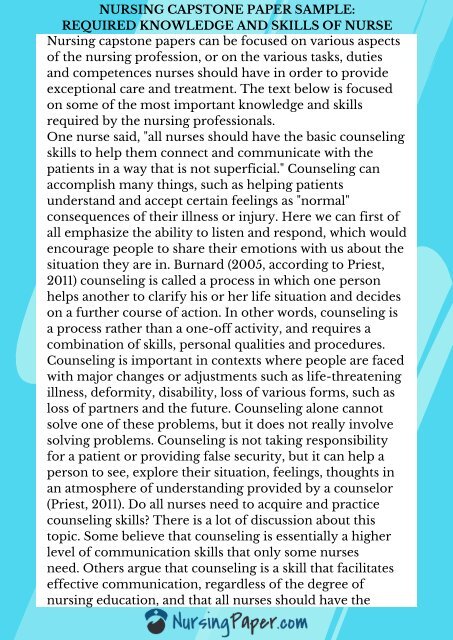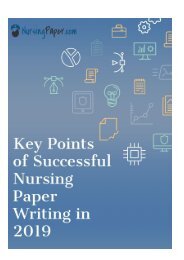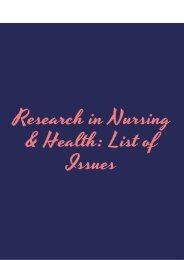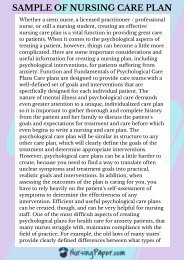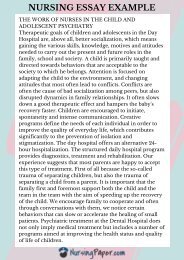Nursing Capstone Paper Sample
Hello! Take a look at this great nursing capstone paper sample that we've prepared for you. If you want to see more samples, visit https://www.nursingpaper.com/our-services/nursing-capstone-paper/
Hello! Take a look at this great nursing capstone paper sample that we've prepared for you. If you want to see more samples, visit https://www.nursingpaper.com/our-services/nursing-capstone-paper/
Create successful ePaper yourself
Turn your PDF publications into a flip-book with our unique Google optimized e-Paper software.
NURSING CAPSTONE PAPER SAMPLE:<br />
REQUIRED KNOWLEDGE AND SKILLS OF NURSE<br />
<strong>Nursing</strong> capstone papers can be focused on various aspects<br />
of the nursing profession, or on the various tasks, duties<br />
and competences nurses should have in order to provide<br />
exceptional care and treatment. The text below is focused<br />
on some of the most important knowledge and skills<br />
required by the nursing professionals.<br />
One nurse said, "all nurses should have the basic counseling<br />
skills to help them connect and communicate with the<br />
patients in a way that is not superficial." Counseling can<br />
accomplish many things, such as helping patients<br />
understand and accept certain feelings as "normal"<br />
consequences of their illness or injury. Here we can first of<br />
all emphasize the ability to listen and respond, which would<br />
encourage people to share their emotions with us about the<br />
situation they are in. Burnard (2005, according to Priest,<br />
2011) counseling is called a process in which one person<br />
helps another to clarify his or her life situation and decides<br />
on a further course of action. In other words, counseling is<br />
a process rather than a one-off activity, and requires a<br />
combination of skills, personal qualities and procedures.<br />
Counseling is important in contexts where people are faced<br />
with major changes or adjustments such as life-threatening<br />
illness, deformity, disability, loss of various forms, such as<br />
loss of partners and the future. Counseling alone cannot<br />
solve one of these problems, but it does not really involve<br />
solving problems. Counseling is not taking responsibility<br />
for a patient or providing false security, but it can help a<br />
person to see, explore their situation, feelings, thoughts in<br />
an atmosphere of understanding provided by a counselor<br />
(Priest, 2011). Do all nurses need to acquire and practice<br />
counseling skills? There is a lot of discussion about this<br />
topic. Some believe that counseling is essentially a higher<br />
level of communication skills that only some nurses<br />
need. Others argue that counseling is a skill that facilitates<br />
effective communication, regardless of the degree of<br />
nursing education, and that all nurses should have the
NURSING CAPSTONE PAPER SAMPLE:<br />
REQUIRED KNOWLEDGE AND SKILLS OF NURSE<br />
counseling skills to be good communicators because it is<br />
primarily the case with the patients. The use of counseling<br />
skills with physically ill people is considered crucial for farreaching<br />
positive consequences, i.e. benefits that cannot be<br />
overestimated. Nichols (1993, according to Priest, 2011)<br />
considers that all competent health professionals should<br />
have basic counseling skills. It is also considered that the<br />
counseling exercise would be useful to improve the<br />
communication of all healthcare professionals. When we<br />
are involved in communicating with another person, our<br />
attention should be such that we are directed directly to<br />
her, so none of our potential distractors hinder it. It is<br />
necessary to keep in mind the tone we speak of, the<br />
expression of the face, the position of the body, the touch<br />
and other nonverbal signs that transmit the message of our<br />
kindness. Interaction and attention to attention implies not<br />
only the physical but also the psychic presence. We need to<br />
be aware of ourselves because awareness of ourselves has a<br />
strong influence on communication. The so-called "giving<br />
of attention" is very difficult to achieve. By exercising, we<br />
can improve our participation skills by using non-verbal<br />
communication. Egan (2001) advocated the SONOO<br />
position, where the letters in the acronym indicate: - direct<br />
seating (does not necessarily mean face to face, but upright<br />
sitting and the ability to clearly represent our person to<br />
another person); Keeping an Open Hold (means that your<br />
arms or legs are not crossed because it can point to the<br />
message "I'm not actually interested in you and / or closed<br />
for what you want to say to me"), - Leaning forward (lightly,<br />
to another person and without exaggeration, effectively<br />
empathizes). - Making contact with the eyes (this social skill<br />
must be at a suitable level: it is estimated that more than 20<br />
seconds of direct contact with the other person may be<br />
perceived as annoying and / or even jeopardizing). -<br />
Relaxation (It's not easy to realize when you focus on all<br />
other SONOO position elements, but with exercise, we
NURSING CAPSTONE PAPER SAMPLE:<br />
REQUIRED KNOWLEDGE AND SKILLS OF NURSE<br />
develop our own version of the position that is pleasing to<br />
us and allows us to feel as relaxed as possible in the<br />
situation.<br />
Active listening must be purposeful. One of the most<br />
significant segments in verbal communication with the<br />
patient. It is often neglected, and the reason for this is the<br />
rapid progress and development of technological and<br />
pharmacologically sophisticated diagnostic and therapeutic<br />
possibilities, as well as increasingly complex nursing /<br />
health documentation. Active listening comprehensively<br />
covers what the speaker wants to say. A nurse should be<br />
able to listen to patient messages, to figure out their<br />
meanings and to give feedback that messages are<br />
understood (Bryant, 2009). Therapy communication<br />
begins with active listening and is a prerequisite for<br />
empathy and assertiveness. Active listening techniques<br />
include: setting up the call, facilitating, clarifying,<br />
recognizing unread, reflecting and compressing. We are<br />
interested in asking questions and showing that we are<br />
following the interviewee. Facilitation or facilitation is<br />
encouraging conversation with nonverbal and verbal signs.<br />
Explain the need for both general and vague statements.<br />
Then it follows the recognition of the unlimited: thoughts<br />
and feelings. We apply reflection to messages and<br />
emotions. By rephrasing, we repeat the key thought, but<br />
more concisely. At the end of conversation, it is important<br />
to summarize and it is an important skill; the key data,<br />
tasks, messages and goals are summarized. When listening<br />
active, it is of utmost importance to use non-verbal signs of<br />
active listening, to keep track of the interviewer and to be<br />
aware of his non-verbal communication. All this involves<br />
contact with the eyes, avoiding excessive movement and<br />
gesture. It has to be in a position opposite the patient, face<br />
to face, leaning slightly forward, relaxed, open gesture, and<br />
comfortable posture of the body.
NURSING CAPSTONE PAPER SAMPLE:<br />
REQUIRED KNOWLEDGE AND SKILLS OF NURSE<br />
With regard to additional active listening instructions, they<br />
relate to the need to stop activities that are not essential to<br />
listening and to prevent obstructions, revolve their own<br />
obstructions and fatigue. We have to decide to listen and<br />
prepare, documentation and everything that needs to be<br />
available, and it is important that we are prepared in<br />
advance. Listening should be empathic, without<br />
interruption, we must be involved, providing enough time<br />
and space for the interlocutor. It is important that we<br />
finally check if we all understand.<br />
References<br />
Priest, H. (2011) An Introduction to Psychological Care in<br />
<strong>Nursing</strong> and the Health Professions. Abingdon: Routledge.<br />
Egan, G. (2001) The skilled helper: A problem -<br />
Management and Opportunity, Development Approach to<br />
Helping (7th ed.). Stamford: Wadsworth.<br />
Bryant, L. (2009). The art of active listening. Practice Nurse,<br />
37 (6), 49–52


